Below find the link to Class 3 in the ABCs of Orthodoxy series. This class was presented October 7, 2021. Please start the playback at 2.00 Min. to avoid early class conversation not part of the presentation. Thank you and God Bless FrG
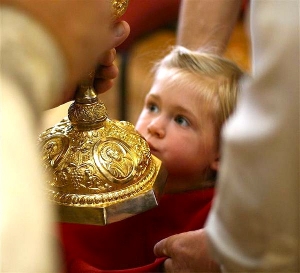
Father George Bithos' weblog
Below find the link to Class 3 in the ABCs of Orthodoxy series. This class was presented October 7, 2021. Please start the playback at 2.00 Min. to avoid early class conversation not part of the presentation. Thank you and God Bless FrG
Below please find the link to the video of Class 2. PLEASE start playback at 33.00 min. to avoid considerable dead time, which is just conversation and not the class content in the video. Thank you…..FrG
https://youtu.be/NDL0Z_c7PJY?t=26
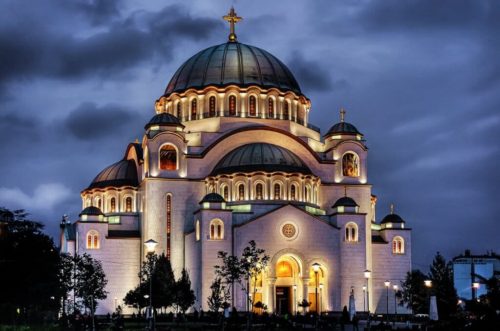
St Savas Cathedral – Belgrade
This quote explains why we build churches to God’s glory. It is a quote from St. Philaret of Moscow on the occasion of a church consecration.
“God is everywhere and doesn’t need churches, which are small for him and cannot contain Him. But man is limited, and thus needs limited revelation of God’s presence. God condescended to the need of man and granted that this church exist, granting it the grace of His particular presence. We know of only one state of man in which he has no need of churches: the eternal life in the New Jerusalem, under a “new heaven and a new earth…” the seer of heaven (St. John the Evangelist) notes a special distinguishing feature of the New Jerusalem, namely that there is no church there: “and I saw no church there: (Rev. 21, 22). But we are not yet in the New Jerusalem, which will descend from the heavens, therefore we need a church temple. Belonging to the creation, after the fall, our own flesh, rough and unpurified, blocks our entrance into the grace-filled presence of God. This is why it is necessary for His charismatic presence to reveal itself to us in holy churches. The heavens – where Christ, our light, ascended – have not yet opened up and revealed to us the radiance of His glory. because of this we need for the time being at least a small heaven on earth, as well as light – even though it may be hidden in mystery. We can find all this in the church, through prayer, the word of God and the sacraments
God Bless…….Fr G.
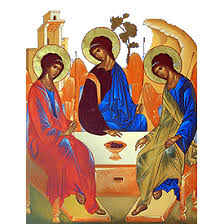
Have you ever considered the possibility that your idea of God is too small? What do you think about when you hear the word “GOD”? Maybe, it would help if we consider some of the Church’s teachings about God. First, let’s ask the basic question Who is God?” There are certain fundamental Orthodox teachings on this question. When we try to define God, we come to Mystery. Beginning with that question: What is God? The Church says “GOD IS” – He is beyond all human understanding, language, and abilities to grasp or describe.
God is Love; whoever sought to define Him would be like a blind person trying to count the grains of sand of the sea shore. – St. John Climakos
God is a God, who out of Love, reveals Himself to his creatures and creation. Our God is a Personal God, that is why the question is WHO is GOD and not WHAT is God. Our God is a TRINITARIAN GOD. What does this mean? The nature of God as Trinity is explained St. Basil in this way:
The Father is the origin of all, the Son realizes, and the Spirit fulfills. Every thing subsists by the will of the Father, comes into being though the action of the Son, and reaches its perfection through the action of the Holy Spirit…The number three therefore comes to your mind: the Lord who commands, The Word who creates, the Breath who confirms and what can it mean to confirm, if not to make perfect in holiness.
Treatise on the Holy Spirit – ST BASIL OF CAESARIA.
Think about the description of the nature of God, as we can understand him. Keep in mind; we can never understand the essence of God. Yet, all Three Persons of the Holy Trinity share the same essence (Nicene-Constantinopolitan Creed). They are unique persons; they are distinct but never separate. They have but one will, the will of the Father. NONE of three ever acts separately and apart from the other two. Metropolitan Kallistos Ware states, “They are not three Gods but one God.” What is it about God that we experience and know? We Orthodox view what and how we experience the Trinity in this way.
God is love (1 John, 8). The Persons of the Holy Trinity relate to one and another in a bond of LOVE, a perfect outpouring of selfless communion that is continuous, constant and mysterious. This is the nature of the relationship of the life of God as Trinity. Our destiny is to share this love and to express it in our lives. When we talk about God, we mean the Holy Trinity; and when we will speak of Christ, the second person of the Trinity, we speak of the Son of God revealed and encountered in the created world. In Christ, empowered by God’s Holy Spirit and through our Baptism and Chrismation, we have the potential to partake in the nature of God as Trinity (2 Peter 1, 3).
For Orthodox, the true image of God and the true nature of man are revealed in history by one event. God has revealed Himself to us in Christ. Through the Holy Spirit and the Virgin Mary, the Theotokos,. Christ accomplishes this by His Incarnation in the Flesh. The Incarnation of our Savior, the Lord Jesus Christ, reveals the image of the Father to the world and only through Him, in the Holy Spirit, can we KNOW God the Father (St. John 17, 25-26). The hymn of Christmas, by St. Romanos the Melodist, summarizes the theology of incarnation with this phrase, “A new born child; God before the Ages”.
The Incarnation is an act of GOD out of love. It is an act of God identifying with our nature and of sharing His Nature with us. The nature of God as Trinity was the topic of the first two Ecumenical Councils; the next five great Councils dealt with who is Jesus and what is His relationship to us, His creation.
Earlier we said, the Godhead is a perfect community of love shared between the THREE Persons of the Trinity. The Incarnation is also about sharing and participation. Christ shares our humanity, even to death on the cross. This act of perfect Love enables us, in Christ, through His Spirit to participate in the life of God. We are called to intimate communion, even friendship with our Lord. The entire history of Christ in the world can be summed up in one word ENCOUNTER. Through Him, in Him and with Him, we encounter the Living God. Christ assumed our human nature and our human body. He transformed them with the Glory of God and showed us the true original beauty of our created potential. He presents it to His Father, wholly transfigured, so that we might share in the Nature of God.
This is the reason why the Word of God was made flesh, and the Son of God became the Son of Man: so that we could enter into communion with the Word of God and by receiving adoption might become the Sons of God. Indeed, we should not be able to share in immortality without a close union with the Immortal.
St. Ireneaus of Lyons
In Christ, we are called to KNOW the Father. This knowledge is the prayer of Christ before his crucifixion. His Resurrection abolished the hold which death had on us since our fall. His Accession granted us an intercessor at the Throne of God. At Pentecost, He asks the Father to send His Spirit to continue His Presence among us. His Second Coming will give the righteous immortality and perfect communion with God. These words of prayer explain our relationship to God the Holy Trinity.
My hope is the Father,
My refuge is the Son.
My Protection is the Holy Spirit,
O Holy Trinity – Glory to You.
St. Ioannikios the Great
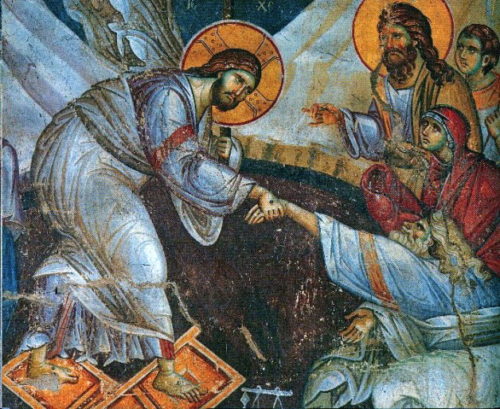
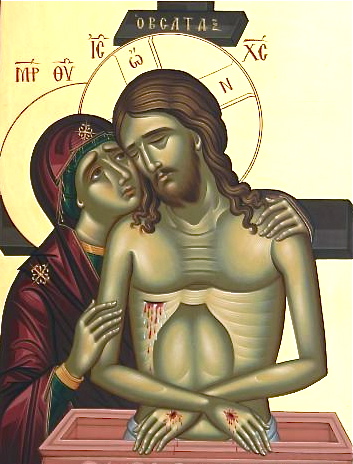
There is a word that appears in the hymnography of the Church which is prominent in Great Lent and in Holy Week. That word is stavrotheotokion. If we look at this compound word and break it down to its component parts we can recognize a couple of fairly familiar Greek words, Stavro – Greek for cross and Theotokos, the Mother of God. Now, we can connect the concepts The Theotokos and the Cross. The Stavrotheotokion is a troparion (short hymn with a theme usually sung after a verse of psalm), which is a manifestation of true human emotions. It is a poetic expression of the pain, sorrow and astonishment of a mother beholding her Son and her God on the Cross. These verses of theology and tenderness are heard in many of the services of the Great Lent, but reach their zenith in the services of the Holy Passion. The Theotokos expresses the wonder of us all. The awe, which could only be articulated by a mother who has kept a secret for many years (“and his mother kept all these things in her heart” Luke 2, 51). The identity of her Son as the incarnate God was known the Theotokos since the Annunciation. Now at the Cross she suffers a new mystery, the inscrutability of her Son and Creator taking on death by His own free choice. Each of these verses proclaims the truth of Christ’s condescension.
…”Woe is me beloved Child, light of my eyes! Thou has hung the earth above the waters, how can you endure to be nailed upon the Tree between two evildoers.” – Vespers of Tuesday in the Third Week.
Nonetheless, the Virgin stands by the cross, hour by hour true to her mission to intercede for the entire world. Her pain is palpable. Her lament is moving and yet there is true nobility in her devotion. When all the disciples, except John the Beloved, had fled because of their fear, she and the other women stood there unafraid. St. Romanos the Melodist has captured her grief and her consolation in a kontakion (a combination of troparia of the same structure, connect alphabetically or acrostically) used on Great and Holy Friday. As we, the Church prepare for Holy Week and the revelation of the pain and suffering of Christ, Our Lord and God we will also be reminded of the deep sorrow of His mother as she stands by the Cross with pain in her heart and tears in her eyes. The dialogue between the Theotokos and her Son becomes the revelation of God’s plan of salvation in poetry. This kontakion is lyrical theology, the stavrotheotokion with the voice of response by our Crucified Lord. Christ assures the Theotokos just as she witnesses his hanging on the Cross, she would receive the grace of being the first to see His glorious resurrection.
“Courage, Mother because you will see me first on my coming from the tomb. I am coming to show you by how many toils I ransomed Adam and how much I sweated for his sake. I shall show it to my friends by showing the marks in my hands and then you will see Eve, Mother, living as before, and you will cry out with joy: ‘He has saved my forebears, my Son and my God.’*
*(St. Romanos the Melodist. On the Life of Christ: Kontakia. Translated by Archimandrite Ephrem Lash. Edited by Kerry Brown, The Sacred Literature Series. New York et al.: HarperCollins Publishers, 1995, p. 148).
![]()
For Orthodox, the true image of God and the true nature of man are revealed in history by one event. God has revealed Himself to us in Christ. Through the Holy Spirit and the Virgin Mary, the Theotokos, Christ accomplishes this by His Incarnation in the Flesh. The Incarnation of our Savior, the Lord Jesus Christ, reveals the image of the Father to the world and only through Him, in the Holy Spirit, can we KNOW God the Father (St. John 17, 25-26). The hymn of Christmas, by St. Romanos the Melodist, summarizes the theology of incarnation with this phrase, “A new born child; God before the Ages”.
The Incarnation is an act of GOD out of love. It is an act of God identifying with our nature and of sharing His Nature with us. The nature of God as Trinity was the topic of the first two Ecumenical Councils; the next five great Councils dealt with who is Jesus and what is His relationship to us, His creation.
Our God as Trinity is a perfect community of love shared between the Three Persons of one essence. The Incarnation is also about sharing and participation. Christ shares our humanity, even to death on the cross. This act of perfect love enables us, in Christ, through His Spirit to participate in the life of God. We are called to intimate communion, even friendship with our Lord. The entire history of Christ in the world can be summed up in one word ENCOUNTER. Through Him, in Him and with Him, we encounter the Living God. Christ assumed our human nature and our human body. He transformed them with the Glory of God and showed us the true original beauty of our created potential. In His Ascension He present our humanity to His Father, wholly transfigured, so that we might share in the Nature of God. As we celebrate the great miracle of Christ’s incarnation let us allow Christ to be born in our hearts as He was born in that humble manger in a cave. By allowing Christ to be born within us we can become His presence in the world to love our fellow human beings as He loves us.
Ria and I wish you and your families a blessed Nativity and a joyous 2021. God Bless Fr. G

Before I answer the question below, I want to point out the great loss of our heritage. The above icon is from the Exo-narthex of the Great Church of Chora in Constantinople now turned into a mosque by the Turkish government. May Our Lord, the Saviour, protect His Church in Chora and keep it safe.
When Mary and Joseph traveled from Nazareth to Bethlehem to pay their taxes, how long would the trip have taken?
A. The distance “as the crow flies” from Nazareth to Bethlehem is about 70 miles. Under normal circumstances, without too many winding roads or rough spots to traverse, people might well have been able to travel (on foot or by donkey) about 20 miles a day, for a total one-way trip of perhaps four days. However, we must keep in mind several factors that might have made this particular journey last longer.
First, the land of Samaria lay along the most direct route between Nazareth and Bethlehem, and in Jesus’ day, there was considerable hostility between Jews and Samaritans. Even if, as I think we can assume, Our Lady and St. Joseph bore no animosity toward Samaritans, it would have been difficult and even dangerous for them to travel through that country. They might have been harassed and would almost certainly have been refused lodging, just as Jesus and His disciples were treated some years later (see Luke 9:51-56).
Surely St. Joseph would have sought to protect his wife, and the Child she carried, from such a threat. So, as was common among the Jews of the day, the holy couple would probably have journeyed far off the “direct” route to avoid Samaria, taking a detour from Galilee across the Jordan River and then back again into Judea farther south. That would have added many miles, and several days, to the journey.
Second, remember that Mary was close to the end of her pregnancy. No doubt they had to travel much more slowly than normal to avoid excessive discomfort for her and risks to the health of both mother and Child.
Given these factors, the one-way trip may have taken a week or ten days, and perhaps much longer.
Second, remember that Mary was close to the end of her pregnancy. No doubt they had to travel much more slowly than normal to avoid excessive discomfort for her and risks to the health of both mother and Child.
Given these factors, my guess is that the one-way trip took at least a week or ten days, and perhaps much longer.

St. Katherine the Great Martyr
Today when we admire someone who is beautiful, witty and bright we might say, she’s the whole package. This is a perfect description of St. Katherine the Great Martyr. Katherine lived in the early 4th century in the city of Alexandria. Highly educated, beautiful, articulate and of royal blood, Katherine confronted the Emperor Maxentius and professed her faith in Christ. The emperor summoned fifty pagan philosophers to debate Katherine on matters of faith. Catherine(another spelling) refuted their arguments so convincingly that many of her learned opponents accepted Christ. Maxentius was infuriated and ordered Katherine tortured and many of the new converts put to death.
Tortured and imprisoned her courage and deep faith influenced over 200 additional souls to embrace faith in Christ including the emperor’s wife Valeria Maximilla. They too were also martyred. Maxentius tried to entice Katherine by an offer of marriage, but the princes would have none of it. She face even more terrible tortures. The Emperor sentenced Katherine to be tortured on a spoked wheel, which broke in pieces when Katherine touched it. Many icons of the great saint depict her standing next to a wheel. Katherine was finally beheaded at the young age of 18. With her faith and dedication to Christ she earned the grace of the Holy Spirit and the crown of a Great Martyr of the Church. Throughout the centuries many miracles have been accomplished through the intercessions of St. Katherine. She has appeared to many faithful to comfort them in times of distress. The Emperor Justinian named the Monastery on Mt. Sinai in her honour and it is one of the primary pilgrim destinations in the Orthodox world. Holy Martyr of God, Katherine, pray for us.

This Saturday we celebrated the Entry of the Theotokos into the Temple. What we know about this event in the life of the Theotokos can be found in two ancient sources. The Protoevagelium of James and The Gospel of the Birth of Mary. These are materials that were not placed in the canonical sources. Some non-Orthodox “experts” have called these writings the “lost books” or “new sources” They were never lost nor are they new. Orthodox monastics and theologians have always used these sources to expand our understanding of the lives of the saints and events in salvation history. The hymnographers, iconographers and poets of the Church have drawn on these writings to enrich our liturgical and faith experience. These writings give the early events of the life of the Theotokos. The Protoevagelium Jacobi (aka The Infancy Gospel of James) presents the more detailed story of the events of her parental heritage, conception, birth and early life. As we know in the canonical Gospel of Luke, St. Luke begins his narrative with the story of St. John the Baptist and then relates the events of the Annunciation to the Theotokos. So these other sources are valuable as they present some of the rest of the Theotokos’ story.
The Protoevagelium relates that Joachim and Anna, the Theotokos’ parents, were so grateful to God for His gift of the conception of Mary; they promised to dedicate Mary to God by presenting her to the Temple. The miracle of their having this blessed child erased the reproval of their community because of their inability to bear children. The thinking of that culture was that a childless couple could not participate in the possibility of being heirs to the promise of the future messiah. When Mary reached the age of three, they fulfilled their pledge and escorted her accompanied by 10 virgins with lit lamps to the Temple. This was prophesied in Psalm 44 LXXII [45]. They were met by the High Priest Zacharias, who guided the child Mary into the Holy of Holies. We hear in the Protoevagelium, “Now Mary was in the Temple of the Lord like a dove being fed and she received food from the hand of an angel.” This was the Archangel Gabriel (notice the top left corner of the icon). What happened from age three until the mid-teenage years when we know that the Annunciation took place is not completely detailed. But we know the Virgin piously stayed in the Temple and found favour with God until her betrothal to Joseph.
The material concerning these years can be found in these ancient writings, As we commemorate these events perhaps reading some of these books could expand your understanding. We must know that the Church has not endorsed these writings as canonical, but looks on them as resources to expand and enhance our faith journey. God Bless and Have a Blessed Thanksgiving